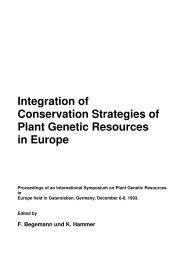Agrobiodiversität in Deutschland - Genres
Agrobiodiversität in Deutschland - Genres
Agrobiodiversität in Deutschland - Genres
Erfolgreiche ePaper selbst erstellen
Machen Sie aus Ihren PDF Publikationen ein blätterbares Flipbook mit unserer einzigartigen Google optimierten e-Paper Software.
18 | Johannes Engels<br />
From the earliest conservation and use activities<br />
of genetic resources until today<br />
zugänglich zu machen, e<strong>in</strong>schließlich der Erlaubnis, genetische Ressourcen<br />
nach vorherigem E<strong>in</strong>verständnis zu sammeln. Das Übere<strong>in</strong>kommen führte das<br />
Konzept des Zugangs zu genetischen Ressourcen und des gerechten Ausgleichs<br />
der aus ihrer Nutzung entstehenden Vorteile e<strong>in</strong>. Dieses wurde im Internationalen<br />
Vertrag zu Pflanzengenetischen Ressourcen (ITPGRFA (2004)) weiter<br />
ausgearbeitet. Der Internationale Vertrag etablierte das „multilaterale System<br />
für e<strong>in</strong>en erleichterten Zugang zu pflanzengenetischen Ressourcen“ für annähernd<br />
35 Nutzpflanzen- und ca. 30 Grasarten unter staatlicher Kontrolle und<br />
Management.<br />
Schlussfolgernd waren, nach den heutigen gesetzlichen Standards und Regelungen,<br />
sowohl von Humboldt als auch Vavilov Biopiraten. Wie dem auch sei,<br />
wir können froh se<strong>in</strong>, dass sie ihre Forschungen durchgeführt haben, da diese,<br />
direkt oder <strong>in</strong>direkt, zur Entwicklung des Konzepts der Genbanken beigetragen<br />
und schließlich zur Gründung e<strong>in</strong>er der ersten Genbanken weltweit geführt<br />
haben - und das vor fast hundert Jahren! Heute können wir sagen, dass Genbanken<br />
e<strong>in</strong> sicherer Hafen für genetische Ressourcen s<strong>in</strong>d. Wir müssen aber<br />
sicher stellen, dass ihre bedeutende Rolle nicht durch restriktive und/oder komplizierte<br />
gesetzliche Regelungen untergraben wird.<br />
Introduction<br />
The 20 th anniversary of the national Information and Coord<strong>in</strong>ation Centre<br />
for Biological Diversity (IBV) of the Federal Office for Agriculture and Food<br />
(BLE) is <strong>in</strong>deed an opportune moment to reflect on the developments with<br />
respect to agricultural biodiversity <strong>in</strong> Germany and beyond, to assess the<br />
current situation and to make a projection <strong>in</strong>to the future. The author is<br />
grateful to have been <strong>in</strong>vited to this Symposium and to jo<strong>in</strong>tly with key<br />
players <strong>in</strong> Germany celebrate this memorable event. Hav<strong>in</strong>g been closely<br />
related to and to a certa<strong>in</strong> degree even <strong>in</strong>volved <strong>in</strong> the developments of the<br />
conservation and susta<strong>in</strong>able use of plant genetic resources for food and<br />
agriculture (PGRFA) over the past 30 years or so, and hav<strong>in</strong>g been a staff<br />
member of Bioversity International (and its predecessor <strong>in</strong>stitutes IPGRI<br />
and IBPGR), one of the centres of the Consultative Group on International<br />
Agricultural Research (CGIAR), I would like to place my appreciations for<br />
the PGRFA activities <strong>in</strong> Germany and the contributions to the <strong>in</strong>ternational<br />
PGRFA system.<br />
To be mentioned here <strong>in</strong> particular are the substantive contributions s<strong>in</strong>ce<br />
the mid-eighties to the Commission on Genetic Resources for Food and Agriculture<br />
of the Food and Agricultural Organization of the United Nations<br />
(FAO), it’s International Undertak<strong>in</strong>g and its successor the International<br />
Treaty on Plant Genetic Resources for Food and Agriculture; s<strong>in</strong>ce the early<br />
n<strong>in</strong>eties to the Convention for Biological Diversity (CBD); the early decision<br />
of Germany dur<strong>in</strong>g the first part of the seventies to contribute to the<br />
establishment and operation of two <strong>in</strong>ternational genebanks <strong>in</strong> Costa Rica<br />
and Ethiopia through the Deutsche Gesellschaft für Internationale Zusammenarbeit<br />
(GIZ, previously GTZ) with the support of the Federal M<strong>in</strong>istry<br />
for Economic Cooperation (BMZ). At the national level, largely through the<br />
active engagement and coord<strong>in</strong>ation of the IBV, Germany has developed an<br />
exemplary national programme on the conservation and susta<strong>in</strong>able use of<br />
genetic resources for food and agriculture with a clear vision and a strategic<br />
and holistic approach, operat<strong>in</strong>g <strong>in</strong> a transparent and <strong>in</strong>teractive manner.<br />
For all these achievements I would like to congratulate IBV’s staff, especially<br />
its long-stand<strong>in</strong>g leader Dr. Frank Begemann, and hope that this strong<br />
organization might see many more ‘happy returns’!<br />
The title of this presentation <strong>in</strong>cludes a rather rhetoric question with regard<br />
to PGRFA and <strong>in</strong> a certa<strong>in</strong> way this question reflects the political developments<br />
that took place s<strong>in</strong>ce PGRFA got onto the scientific and political agenda<br />
dur<strong>in</strong>g the second half of the last century. Therefore, it is a challenge and<br />
an honour to address this question and I will try to deal with the major aspects<br />
and dimensions <strong>in</strong> answer<strong>in</strong>g. I should mention that my deliberations<br />
will be somewhat biased towards plants as they have been the ma<strong>in</strong>stay of<br />
my own experiences but possibly are also the sector of genetic resources that<br />
certa<strong>in</strong>ly politically have been the fore riders. It should also be noted that<br />
the views expressed are my personal ones.<br />
The presentation will address the domestication of plants, the orig<strong>in</strong>s of<br />
agriculture and the role of farmers <strong>in</strong> this evolutionary process. It will then<br />
deal with the centres of diversity and germplasm movement. The relationship<br />
between genetic diversity and plant collectors, <strong>in</strong>clud<strong>in</strong>g the role and<br />
Johannes Engels | 19










